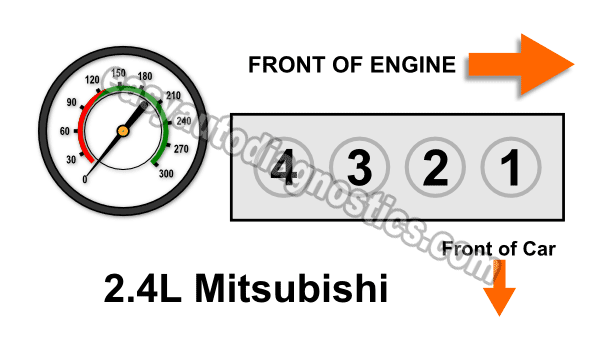
Doing a compression test on your 1.8L or 2.4L Mitsubishi (Chrysler, Dodge) vehicle is a pretty easy test to do and in this article, I'll show you how to get it done.
More importantly, I'm also gonna' show you how to interpret the results of the test.
Why do an engine compression test? Well, it may help you to find out if the engine is shot and if this is the reason why it won't start or the reason you have a hard to diagnose misfire condition.
Contents of this tutorial:
![]() You can find this tutorial in Spanish here: Cómo Probar La Compresión Del Motor (2.4L Mitsubishi) (at: autotecnico-online.com).
You can find this tutorial in Spanish here: Cómo Probar La Compresión Del Motor (2.4L Mitsubishi) (at: autotecnico-online.com).
Important Tips And Suggestions
TIP 1: If your vehicle starts and runs then I suggest that you perform the compression test with a slightly warmed up engine. My recommendation is to let a completely cold engine run for about 15 minutes and no more.
TIP 2: If your vehicle DOES NOT start and run then you don't have to worry about testing the compression of the cylinders with a warmed up engine.
TIP 3: The compression test is done with the engine cranking. So you need to take all necessary safety precautions. Be careful, use common sense and think safety all of the time.
TIP 4: You'll need to remove the spark plugs to perform the compression test. You should never remove spark plugs from a hot engine. Removing spark plugs from a hot engine can and will damage the spark plug threads in the cylinder head. This is a nightmare you do not want to experience.
Which Compression Tester Should I Buy?
There are lot of engine compression testers to choose from and many places to buy them. I'm gonna' make two recommendations to you:
1) Which one to buy: The engine compression tester that I have always used is the Actron CP7827 Compression Tester Kit. My only complaint about this engine compression tester is that it does not come with a case to store it in.
2) Where to buy: You can buy an engine compression tester in any auto parts store in any neighborhood, in any city but you'll be paying at least twice as much. Go to the above compression tester links, browse and compare, you'll see a big price difference!
TEST 1: Dry Compression Test

The illustration above will help you to make sense of the results of the engine compression test, since you need to know the number of the engine cylinder you're testing.
OK, this is what you'll need to do:
- 1
Disable the fuel system. You can easily do this by simply disconnecting the four fuel injectors from their electrical connectors.
Disabling the fuel system will prevent fuel from being injected into the engine cylinders when the engine is being cranked by your helper. - 2
Disable the ignition system.
If your vehicle has the Coil-On-Plug ignition system, you can skip this step and go to step 4 since you've already disabled the ignition system when you removed the ignition coils from the engine to get to the spark plugs.
If your vehicle has a distributor type ignition system, then you can disable the ignition system by disconnecting all of the distributor's electrical connectors. Do not move on to the next step without first doing this. - 3
Disconnect the spark plug wires from the spark plugs. Label the spark plug wires before you disconnect them from the spark plugs.
NOTE: This only applies to the vehicles with an ignition distributor. - 4
Remove the spark plugs.
When removing the spark plugs, be careful not to drop any of them on the floor, or you run the risk of having the spark plugs porcelain insulator crack and then you'll have a misfire on your hands. - 5
Thread the engine compression gauge into the spark plug hole for the number 1 engine cylinder.
Hand tighten the compression gauge only! Do not use any type of tool to get it tight. - 6
Have your helper crank the engine.
- 7
Once the needle on the compression gauge stops climbing, have your helper stop cranking the engine.
- 8
Now, record on paper the value at which the needle stopped and the number of the engine cylinder on a piece of paper.
Release the pressure on the gauge and repeat this step one more time. - 9
Repeat steps 5 and 8 on the remaining three cylinders.
Let's take a look at what your compression test results mean:
CASE 1: No compression in 2 or more cylinders. This test result tells you that the engine has serious internal problems.
The most common issues would be:
- Busted timing belt.
- A blown head gasket.
- The engine threw a rod.
To test for a blown head gasket, see this tutorial: How To Test For a Blown Head Gasket (Mitsubishi 1.8L, 2.4L).
CASE 2: Low compression in one or more cylinders. To a certain point, it's normal for the compression to vary a little between cylinders (as the engine accumulates thousands of miles). But if these values vary too much, then you're gonna' have a bonafide misfire on your hands.
So, your next step is to do the math and find out if these compression values are within normal parameter or not. Go to: Interpreting Your Compression Test Results.



